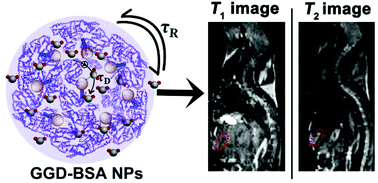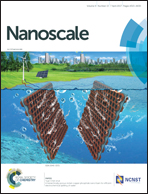Albumin-based nanoparticles loaded with hydrophobic gadolinium chelates as T1–T2 dual-mode contrast agents for accurate liver tumor imaging†
Abstract
Magnetic resonance contrast agents with T1–T2 dual mode contrast capability have attracted considerable interest because they offer complementary and synergistic diagnostic information, leading to high imaging sensitivity and accurate diagnosis. Here, we reported a facile strategy to construct albumin based nanoparticles loaded with hydrophobic gadolinium chelates by hydrophobic interaction for magnetic resonance imaging (MRI). We synthesized a glycyrrhetinic acid-containing Gd-DOTA derivative (GGD) and loaded GGD molecules into BSA nanoparticles to form GGD–BSA nanoparticles (GGD–BSA NPs). The large size and porous structure endow GGD–BSA NPs with geometrical confinement, which restricts the tumbling of GGD and the diffusion of surrounding water molecules. As a result, GGD–BSA NPs exhibit ultrahigh T1 and T2 relaxivities, which are approximately 8-fold higher than those of gadolinium-based clinical contrast agents at 0.5 T. Besides, due to the intrinsic properties of their components, GGD–BSA NPs show good biocompatibility in vitro and in vivo, which warrants their great potential in clinical translation. Furthermore, GGD–BSA NPs show remarkable sensitivity in noninvasive detection of liver tumors by self-confirmed T1–T2 dual-mode contrast-enhanced MRI. All of these merits make GGD–BSA NPs a potential candidate for fruitful biomedical and preclinical applications.



 Please wait while we load your content...
Please wait while we load your content...